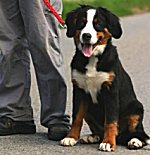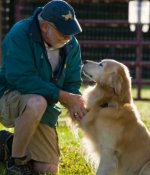Swedish Vallhunds: What's Good About 'Em, What's Bad About 'Em
Swedish Vallhund temperament, personality, training, behavior, pros and cons, advice, and information, by Michele Welton, Dog Trainer, Behavioral Consultant, Author of 15 Dog Books
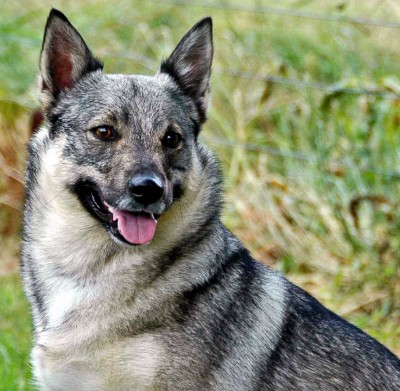
Molly, dearly loved by the Polglase family. Photo © Tony Polglase.
The FCI Standard calls the Swedish Vallhund "watchful, alert, and energetic."
Vallhund is Swedish for shepherd dog. Yes, despite his short legs, this breed is a herding dog.
Spirited and athletic, yet steady and dependable, the Swedish Vallhund is a true "big dog with short legs."
Hiking, herding, obedience, agility, or chasing balls (with surprising speed) are enjoyable outlets for the Vallhund's enthusiasm and desire to work. They love to be challenged with new tasks. See my free online training program, Teach Your Dog 100 English Words.
If his days include such moderate exercise/activities, along with the companionship of his family, he is adaptable and easy to live with.
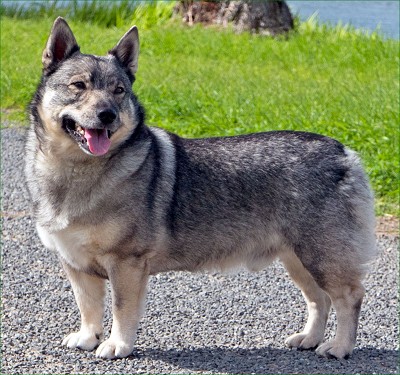
Badger.... happy smile! Beloved companion of the Polglase family. Photo © Tony Polglase.
Most Swedish Vallhunds are friendly (or at least polite) with everyone and make sensible watchdogs. Most are fine with other animals and especially wonderful with livestock, including horses.
This attentive breed learns quickly and responds well to obedience training, but he does combine the independent judgment of a herding breed with the persistent, sometimes manipulative nature of the spitz family. You must have the confidence to establish and consistently enforce rules, or he may make up his own.
Swedish Vallhunds prefer their flock (family members and other pets) to be gathered together and may try to accomplish this by poking or nipping.
Barking is the main behavior issue to control.
If you want a dog who...
- Is a "big dog" with short legs, i.e. built long and low to the ground, but with a robust body, heavy bone, and a working dog temperament
- Has a short easy-care coat
- Is spirited and athletic, but needs only moderate exercise to maintain his muscle tone
- Combines the working intelligence of a herding breed with the playful nature of a spitz
- Is less "bossy" than a Pembroke Welsh Corgi, but less "mellow" than a Cardigan Welsh Corgi
- Is polite with guests and makes a sensible watchdog
- Is usually fine with other family pets, and especially good with livestock
A Swedish Vallhund may be right for you.
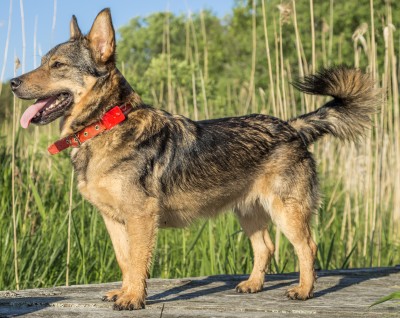
If you don't want to deal with...
- Providing lots of mental stimulation that fulfills his desire to work and gives him something productive to do
- Destructiveness when bored or left alone too much
- Territorial aggression toward dogs and cats he doesn't know
- Strong-willed mind of his own, requiring a confident owner who can take charge
- Chasing and nipping at things that move: children, joggers, other animals, bikes, cars
- Barking
- Heavy shedding
- Waiting lists (hard to find) and a high price tag
A Swedish Vallhund may not be right for you.
 |
Dog Breed Traits – Which Traits Are Right For You? In this brand new series, I'll help you decide which dog breed traits would best suit you and your family, your home and yard, and your lifestyle, so you can choose the best dog breed for your family. |
Keep in mind that the inheritance of temperament is less predictable than the inheritance of physical traits such as size or shedding. Temperament and behavior are also shaped by raising and training.
FREE eBooks by Michele Welton
![]() "Respect Training for Puppies" and "Teach Your Dog 100 English Words" are free step by step guides to teaching your pup to be calm and well-behaved.
"Respect Training for Puppies" and "Teach Your Dog 100 English Words" are free step by step guides to teaching your pup to be calm and well-behaved.
![]() "11 Things You Must Do Right To Keep Your Dog Healthy and Happy" is a free guide to keeping your dog mentally, physically, and emotionally happy and healthy so you can enjoy a longer lifetime of companionship.
"11 Things You Must Do Right To Keep Your Dog Healthy and Happy" is a free guide to keeping your dog mentally, physically, and emotionally happy and healthy so you can enjoy a longer lifetime of companionship.

More traits and characteristics of the Swedish Vallhund
If I was considering a Swedish Vallhund, I would be most concerned about...
- Providing enough exercise and mental stimulation. With their short legs and long body, Swedish Vallhunds don't need or want miles of running exercise. But they are active herding dogs, so they need regular opportunities to vent their energy and to use their busy minds to do interesting things. Otherwise they will become bored, which they usually express by barking and destructive chewing.
I recommend that you get your Swedish Vallhund involved in obedience classes at the intermediate or advanced level, agility (an obstacle course for dogs), tracking, or herding. Otherwise, trying to suppress their "hardwired" working instincts, without providing alternate outlets for their energy, can be difficult and is really not fair to the dog.
- Chasing other animals. One of the Swedish Vallhund's responsibilities was to drive away strange dogs from their owner's farm and flock. Thus, many Swedish Vallhunds are dominant or aggressive toward dogs and cats they don't know.
- Barking. Swedish Vallhunds bark quite a bit, first because they have keen and watchful senses, and second, because they used sharp barks to help control livestock. This is not a good breed choice if you have close neighbors, especially if you're thinking of letting the dog outdoors without your supervision. To make matters worse, some Vallhunds have intense, high-pitched barks that can set your teeth on edge.
- Heavy shedding. Swedish Vallhunds shed a lot, be aware.
- Mind of their own. Swedish Vallhunds are highly intelligent. But like most herding dogs, they do have an independent mind of their own and are not pushovers to raise and train. They can be manipulative or willful. You must show them, through absolute consistency, that you mean what you say.
In other words, you must teach your Swedish Vallhund to respect you. Follow my free Respect Training program.
- Finding one. In the United States, Swedish Vallhunds are very hard to find and expensive.
My best-selling books – now available FREE on my website
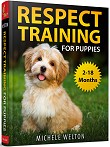 Respect Training For Puppies: 30 seconds to a calm, polite, well-behaved puppy is for puppies 2 to 18 months old. Your puppy will learn the 21 skills that all family dogs need to know. Click here to read for free.
Respect Training For Puppies: 30 seconds to a calm, polite, well-behaved puppy is for puppies 2 to 18 months old. Your puppy will learn the 21 skills that all family dogs need to know. Click here to read for free. Teach Your Dog 100 English Words is a unique Vocabulary and Respect Training Program that will teach your adult dog to listen to you and do what you say. Click here to read for free.
Teach Your Dog 100 English Words is a unique Vocabulary and Respect Training Program that will teach your adult dog to listen to you and do what you say. Click here to read for free. 11 Things You Must Do Right To Keep Your Dog Healthy and Happy helps your dog live a longer, healthier life. Get my honest advice about all 11 Things before you bring home your new puppy, because some mistakes with early health care cannot be undone. Click here to read for free.
11 Things You Must Do Right To Keep Your Dog Healthy and Happy helps your dog live a longer, healthier life. Get my honest advice about all 11 Things before you bring home your new puppy, because some mistakes with early health care cannot be undone. Click here to read for free.Related posts you might enjoy




